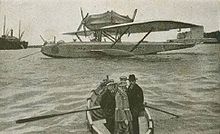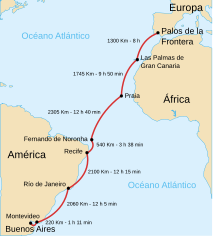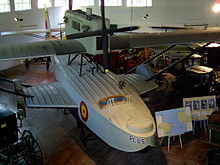Plus Ultra (flying boat)
Plus Ultra is the name of a Dornier Wal - flying boat , which is one of the most famous aircraft in the Spanish aviation history of the 1920s. The name of the aircraft was chosen according to the motto of the Spanish coat of arms Plus Ultra .
history
The Plus Ultra was built as a so-called “military whale” (from 1926/27 referred to as “Do J”) by the Dornier subsidiary CMASA in Marina di Pisa , because of the construction ban in force until May 1922 and the restrictions that still existed thereafter , such aircraft could only be manufactured abroad by straw companies. As early as 1922/23, Dornier had delivered a total of six Dornier whales to the Spanish Air Force. These machines were then converted from the Hispano-Suiza engines, which turned out to be unreliable, to Rolls-Royce engines.
Built with the serial number 40, on November 12th 1925 a German-Spanish crew transported the whale with the registration M-MWAL from Marina di Pisa to Barcelona . In the Spanish Air Force, the machine, which was equipped with 450 hp Napier Lion engines and four-blade propellers, was given the service number W12. In order to increase the range, the Plus Ultra was equipped with a greatly increased tank capacity of 4000 L. The original Plus Ultra flying boat is now in the Museo de Luján in Argentina and a later replica is exhibited in the Museo del Aire aviation museum in Madrid .
Plus ultra expedition
The Plus Ultra flight between Spain and America, with the destination Buenos Aires in Argentina, took off on January 22, 1926 in Palos de la Frontera in the Huelva province in Andalusia in southern Spain . The four crew members of the flying boat were the commander Ramón Franco , the sea captain Julio Ruiz de Alda , the lieutenant Juan Manuel Durán and the mechanic Pablo Rada , all Spaniards. On February 9, 1926, the Plus Ultra landed in Buenos Aires after a flight distance of 10,270 kilometers. The pure flight time with seven stopovers was 59 hours and 39 minutes.
This flight is considered the most important pioneering achievement in Spanish aviation. It took place a year before the American Charles Lindbergh made his transatlantic single flight in the opposite direction.
swell
- The Plus Ultra en the Museo de Luján
- IZQUIERDO, Julio. El vuelo del Plus Ultra ( Memento from June 6, 2004 in the Internet Archive )
- Günter Frost, Karl Kössler , Volker Koos: Dornier - from the beginnings to 1945. HEEL Verlag, 2010, ISBN 978-3-86852-049-1 , pp. 49–54.
Web links
Individual evidence
- ↑ Report on the M-MWAL and the Atlantic crossing, p. 11. (in Spanish, accessed on July 9, 2014)


